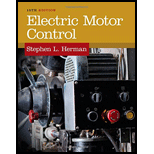
Electric Motor Control
10th Edition
ISBN: 9781133702818
Author: Herman
Publisher: CENGAGE L
expand_more
expand_more
format_list_bulleted
Textbook Question
Chapter 22, Problem 1SQ
Describe what is meant by sequence control.
Expert Solution & Answer
To determine
Describe the meaning of sequence control.
Explanation of Solution
Sequence control:
Sequence control is a method of control to activate all the elements in a sequence manner.
This type of control is necessary wherever the activation of an auxiliary component depends on the main components.
In this control method, the starters are connected in a system such that one motor cannot be energized until another one is in operation.
Applications:
- Using in the systems wherever auxiliary equipment is associated with main systems. For example: hydraulic and lubricating oil pumps.
- Using in conveyor systems (subassembly or main line).
Conclusion:
Thus, the meaning of sequence control has been explained.
Want to see more full solutions like this?
Subscribe now to access step-by-step solutions to millions of textbook problems written by subject matter experts!
Students have asked these similar questions
Don't use ai to answer I will report you answer
Don't use ai to answer I will report you answer
The quantum efficiency of a pin-photodiode is 75 % at a wavelength of 1320 nm. The diode’s capacitance is 11 pF.
For an input optical power of 1 mW, evaluate the mean (4)
Knowledge Booster
Learn more about
Need a deep-dive on the concept behind this application? Look no further. Learn more about this topic, electrical-engineering and related others by exploring similar questions and additional content below.Similar questions
- Don't use ai to answer I will report you answerarrow_forwardanA fluid level control system includes a tank, a level sensor , a fluid source and an actuator to control fluid inflow. Show how the fluid level could be digitally controlled using a block diagramarrow_forwardsee the following imagearrow_forward
- Calculate A, B, C, and D constants, sending end voltage and sending end current of a 3-phase, 50-Hz overhead transmission line 100 km long has the following constants Resistance/km/phase = 0.1, Inductive reactance/km/phase 0.20, Capacitive susceptance/km/phase = 0.04 x 10 siemen. when supplying a balanced load of 10,000 kW at 66 kV, p.f. 0-8 lagging. Use nominal T method. andarrow_forwardDon't use ai to answer I will report you answerarrow_forwardNO AI PLEASE WILL REJECTarrow_forward
- NO AI PLEASE WILL REJECTarrow_forwardDon't use ai to answer I will report you answer. Please give explanation for both correct options and incorrectarrow_forward14:00 APP Voi) 5G 鼷浴醵郯興47% atheva.cc/index/index/index.html The Most Trusted, Secure, Fast, Reliable Cryptocurrency Exchange Get started with the easiest and most secure platform to buy, sell, trade, and earn Cryptocurrency Balance:1000.00 Recharge Withdraw Message About us BTC/USDT ETH/USDT EOS/USDT 83259.00 1841.46 83259.00 +1.02% +0.08% +1.02% Operating norms Symbol B BTC/USDT Latest price 24hFluctuation 83259.00 +1.02% ETH/USDT 1841.46 +0.08% B BTC/USD illı 83259.00 +1.02% Home Markets Trade Record Mine О <arrow_forward
arrow_back_ios
SEE MORE QUESTIONS
arrow_forward_ios
Recommended textbooks for you

Lead and lag compensation using Bode diagrams; Author: John Rossiter;https://www.youtube.com/watch?v=UBE-Tp173vk;License: Standard Youtube License